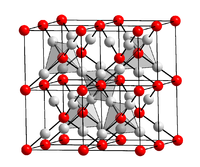Silver sulfide
| Crystal structure | |||||||||||||||||||
|---|---|---|---|---|---|---|---|---|---|---|---|---|---|---|---|---|---|---|---|

|
|||||||||||||||||||
| __ Ag + __ S 2− | |||||||||||||||||||
| General | |||||||||||||||||||
| Surname | Silver sulfide | ||||||||||||||||||
| other names |
|
||||||||||||||||||
| Ratio formula | Ag 2 S | ||||||||||||||||||
| Brief description |
black-gray, odorless solid |
||||||||||||||||||
| External identifiers / databases | |||||||||||||||||||
|
|||||||||||||||||||
| properties | |||||||||||||||||||
| Molar mass | 247.80 g mol −1 | ||||||||||||||||||
| Physical state |
firmly |
||||||||||||||||||
| density |
7.234 g cm −3 |
||||||||||||||||||
| Melting point |
845 ° C |
||||||||||||||||||
| solubility |
extremely sparingly soluble in water |
||||||||||||||||||
| safety instructions | |||||||||||||||||||
|
|||||||||||||||||||
| MAK |
0.01 mg m −3 |
||||||||||||||||||
| Thermodynamic properties | |||||||||||||||||||
| ΔH f 0 |
−32.6 kJ mol −1 |
||||||||||||||||||
| As far as possible and customary, SI units are used. Unless otherwise noted, the data given apply to standard conditions . | |||||||||||||||||||
Silver sulfide (also sulfur silver , colloquially “tarnished” or “oxidized” silver; Ag 2 S ) is a chemical compound from the group of sulfides .
Occurrence
In mineral terms, silver sulfide occurs as acanthite (silver sheen) and as an unstable high-temperature modification argentite .
Extraction and presentation
Silver sulfide is a salt formed from a chemical reaction between sulfur and silver .
It can also be obtained from silver solutions by adding hydrogen sulfide . This salt is extremely sparingly soluble in water .
Silver sulfide can also be obtained from silver and hydrogen sulfide, provided that oxygen is present, since the formation of the sparingly soluble sulfide releases energy and the reduced redox potential of the silver enables oxidation with oxygen.
Another way to make silver sulfide is to sprinkle sulfur on silver and wait for some time.
The separation of this basic substance into its two elements takes place by z. B. is constantly heated in a test tube . Alternatively, silver sulfide can be broken down by heating it to approx. 1000 ° C in a muffle furnace in a crucible . The sulfur evaporates and burns, while molten silver remains. It arises from the recycling of silver waste in chemical laboratories : silver sulfide is precipitated from silver salt solutions by sodium sulfide solution in a nitric acid environment.
Silver sulphide can be removed from silver cutlery or other silver or silver-plated objects as part of silver care, abrasively or more gently by reducing the surface. For example, the top layer can be reduced again in a hot soda or saline solution , in which a piece of aluminum foil is placed, and tarnishing can be reversed (better ventilation if there is a strong odor).
properties
Silver sulfide is a black solid. It is soluble in a KCN solution (potassium cyanide) as well as in concentrated nitric acid and insoluble in aqueous ammonia . It occurs in two modifications. One with a monoclinic crystal structure and the space group P 2 1 / n (space group no. 14, position 2) , a = 4.23, b = 6.91, c = 7.87 Å , β = 99 ° 35 and one with cubic crystal structure with the space group Im 3 m (No. 229) , a = 4.865 Å, 177 ° C. The enthalpy of formation is −31.8 kJ / mol.
Silver sulfide is an electrical non-conductor . This poses a problem when using the highly conductive silver in electronics as a contact material, since contacts and soldered connections made from it or coated with it become unusable due to sulfur compounds in the environment.
Individual evidence
- ↑ a b c d e f Entry on silver sulfide in the GESTIS substance database of the IFA , accessed on February 9, 2020(JavaScript required) .
- ↑ Data sheet silver sulfide at AlfaAesar, accessed on February 27, 2020 ( PDF )(JavaScript required) .
- ↑ David R. Lide (Ed.): CRC Handbook of Chemistry and Physics . 90th edition. (Internet version: 2010), CRC Press / Taylor and Francis, Boca Raton, FL, Standard Thermodynamic Properties of Chemical Substances, pp. 5-4.
- ↑ chemieunterricht.de: Chemistry in and around the house
- ↑ How does the cleaning of tarnished silver work?
- ↑ Georg Brauer (Ed.), With the collaboration of Marianne Baudler a . a .: Handbook of Preparative Inorganic Chemistry. 3rd, revised edition. Volume II, Ferdinand Enke, Stuttgart 1978, ISBN 3-432-87813-3 , p. 1000.
- ↑ Electronic Engineering - Basics: Tab.4.1: Metallic materials and properties ( Memento from January 23, 2013 in the Internet Archive ) (PDF 156.3 kB; p. 2)
